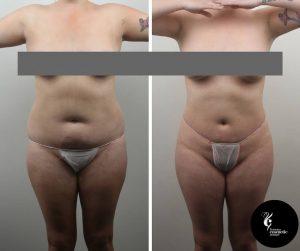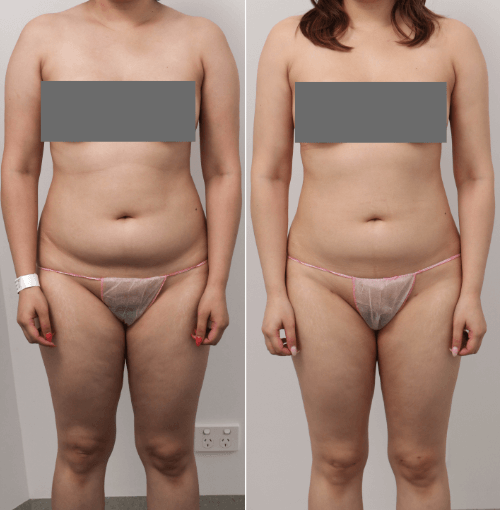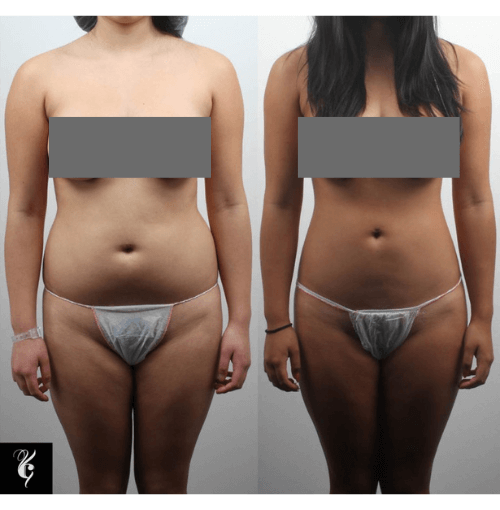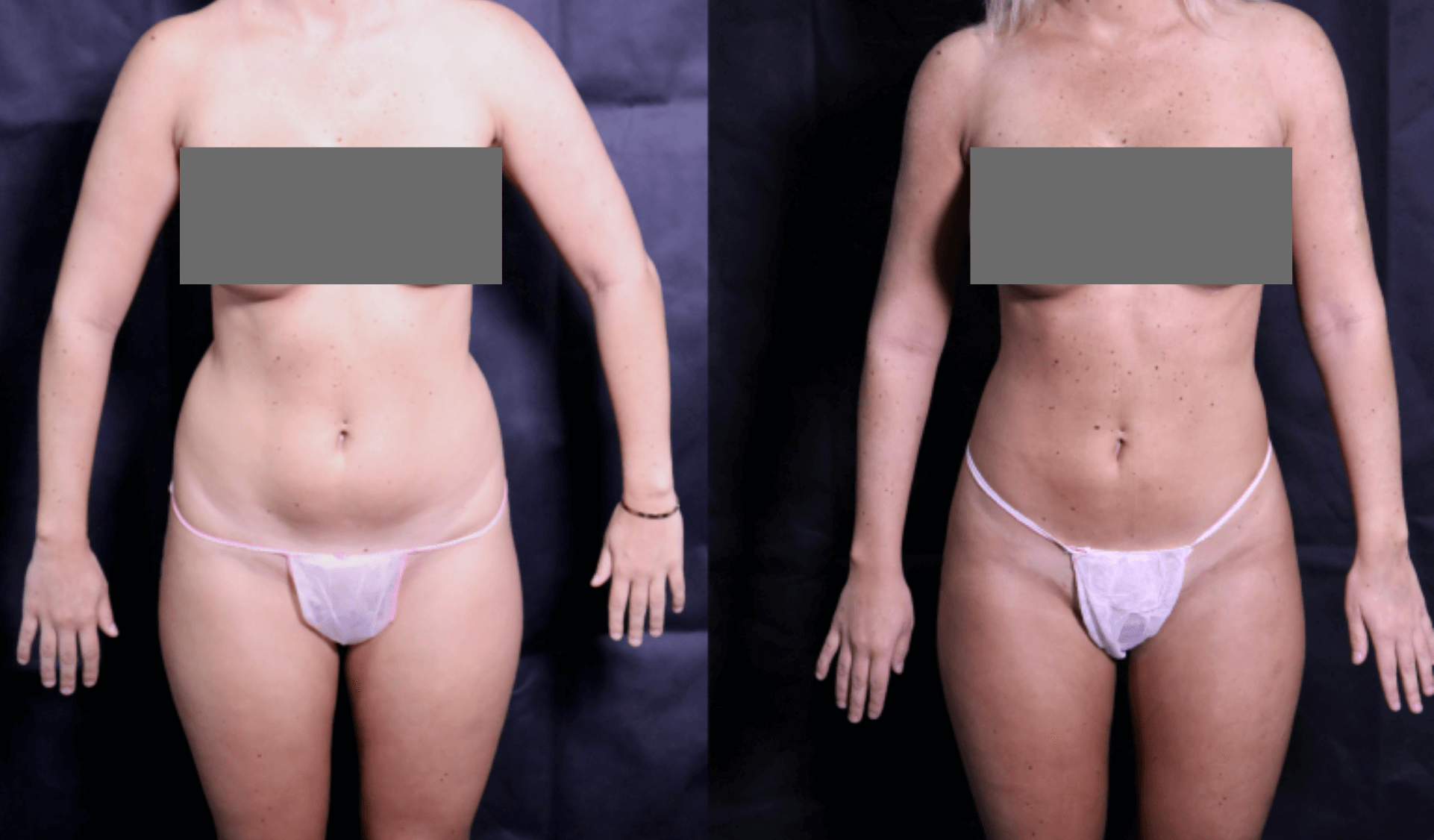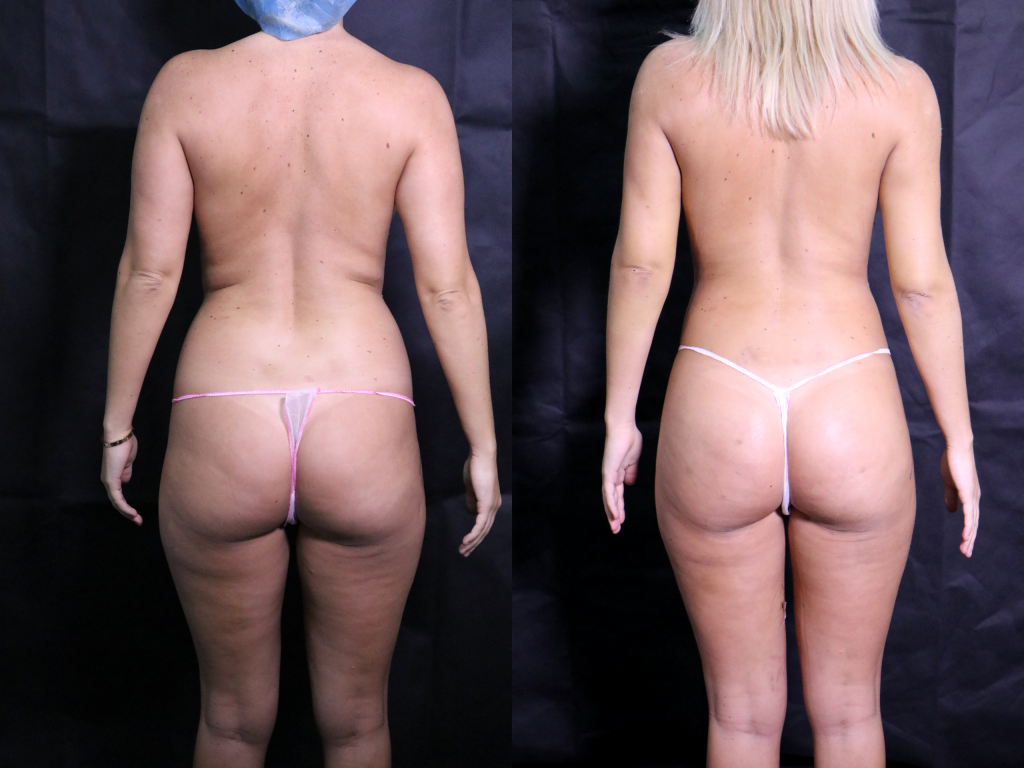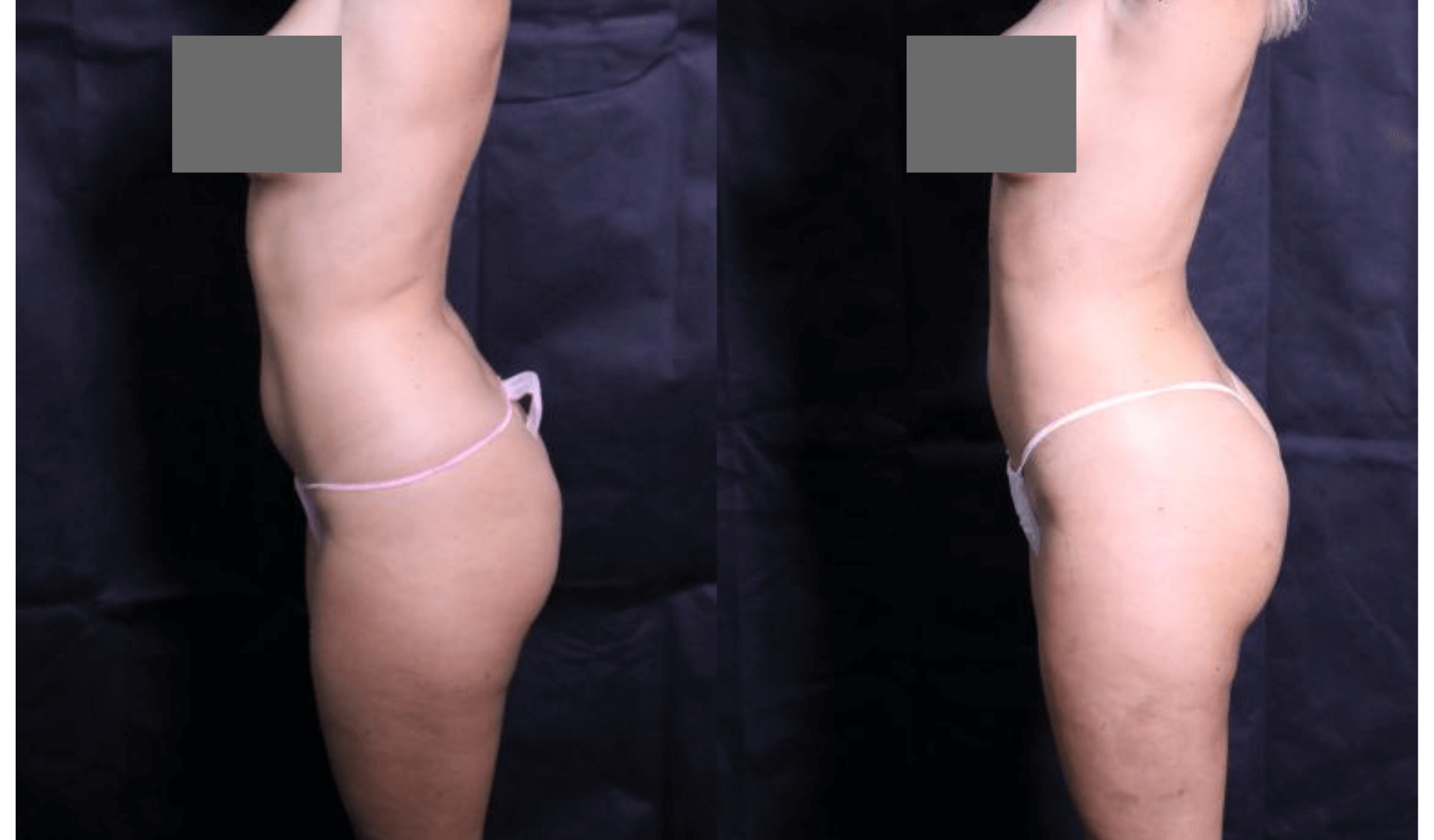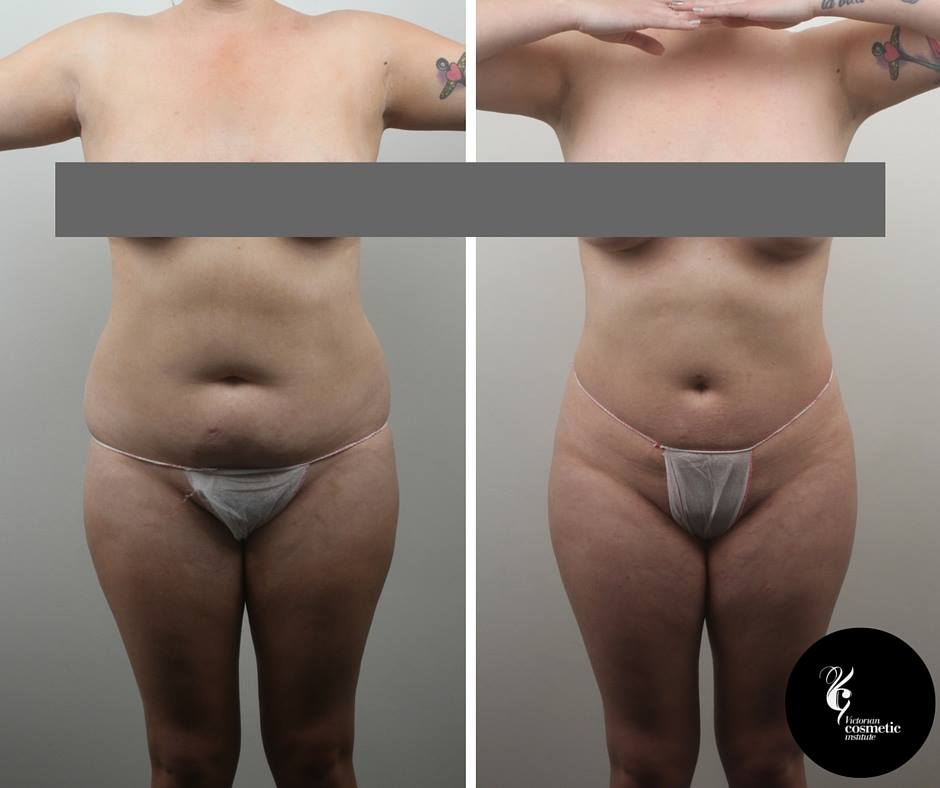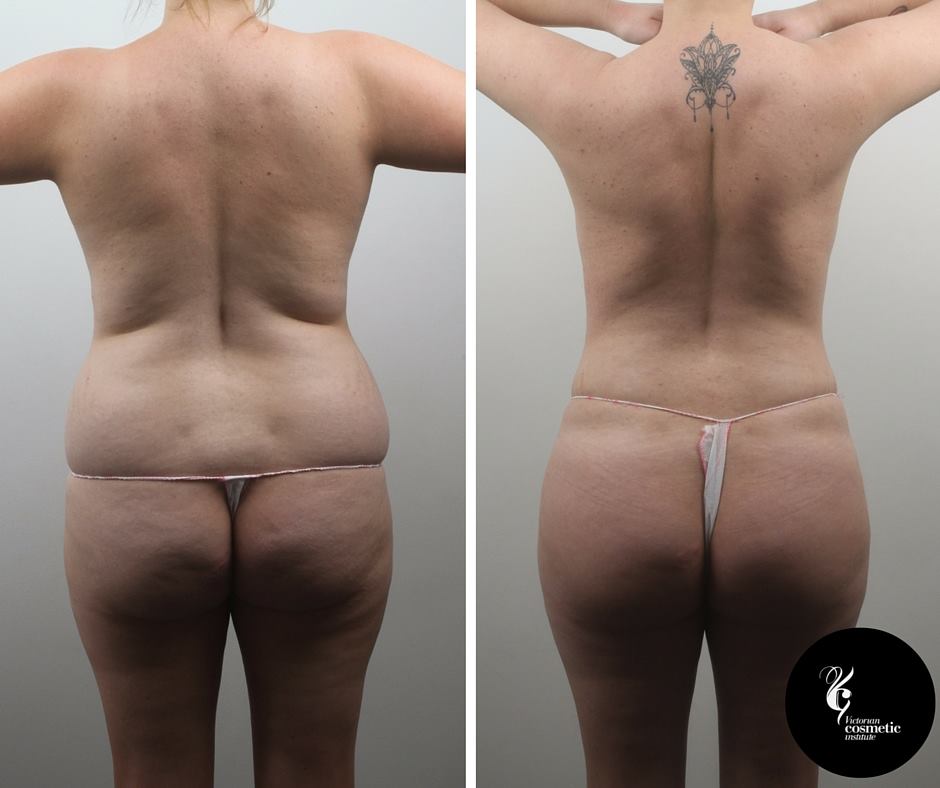What is liposuction?
Liposuction is a surgical procedure performed using a cannula through incisions in the skin. Ideally, the intent of liposuction is to reduce the size of subcutaneous fat deposits. Despite common belief, liposuction is not intended to produce weight loss per se. Instead, it is best suited to those who have a healthy weight and desire the removal of certain subcutaneous fat deposits.
Because genetic factors play a significant role in determining one’s body shape and fat distribution, and excessive fat in specific areas cannot be ‘spot reduced’ with weight loss alone, liposuction may help target and reduce specific fat deposits.
This result is only relevant for this patient and does not necessarily reflect the results other patients may experience. The outcome of each procedure cannot be guaranteed, and individual results may vary for many reasons, including genetics, diet, and exercise. Every medical procedure carries its own set of risks, side effects, and potential complications. Before undergoing any treatment, it is necessary to have a consultation to assess your suitability for the procedure. Patient consent has been obtained to display these images.
How does liposuction work?
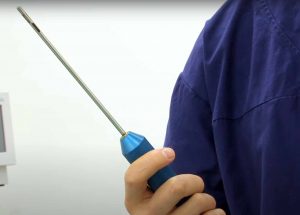 Liposuction can be performed under a general anaesthetic, sedation, or awake. However, in all modern liposuction, a local anaesthetic solution with adrenaline is first infiltrated into the treatment area. The local anaesthetic provides pain relief during and after the procedure, even when performed with a general anaesthetic, and the adrenaline constricts blood vessels and minimises bleeding.
Liposuction can be performed under a general anaesthetic, sedation, or awake. However, in all modern liposuction, a local anaesthetic solution with adrenaline is first infiltrated into the treatment area. The local anaesthetic provides pain relief during and after the procedure, even when performed with a general anaesthetic, and the adrenaline constricts blood vessels and minimises bleeding.
Liposuction is performed with a long hollow metal tube called a cannula through incisions placed in the skin. The cannula is inserted through the different skin incisions and systematically passed through the treatment area from different angles. Negative pressure applied through the cannula causes the fat to be suctioned and removed.
Which areas can I have liposuction on?
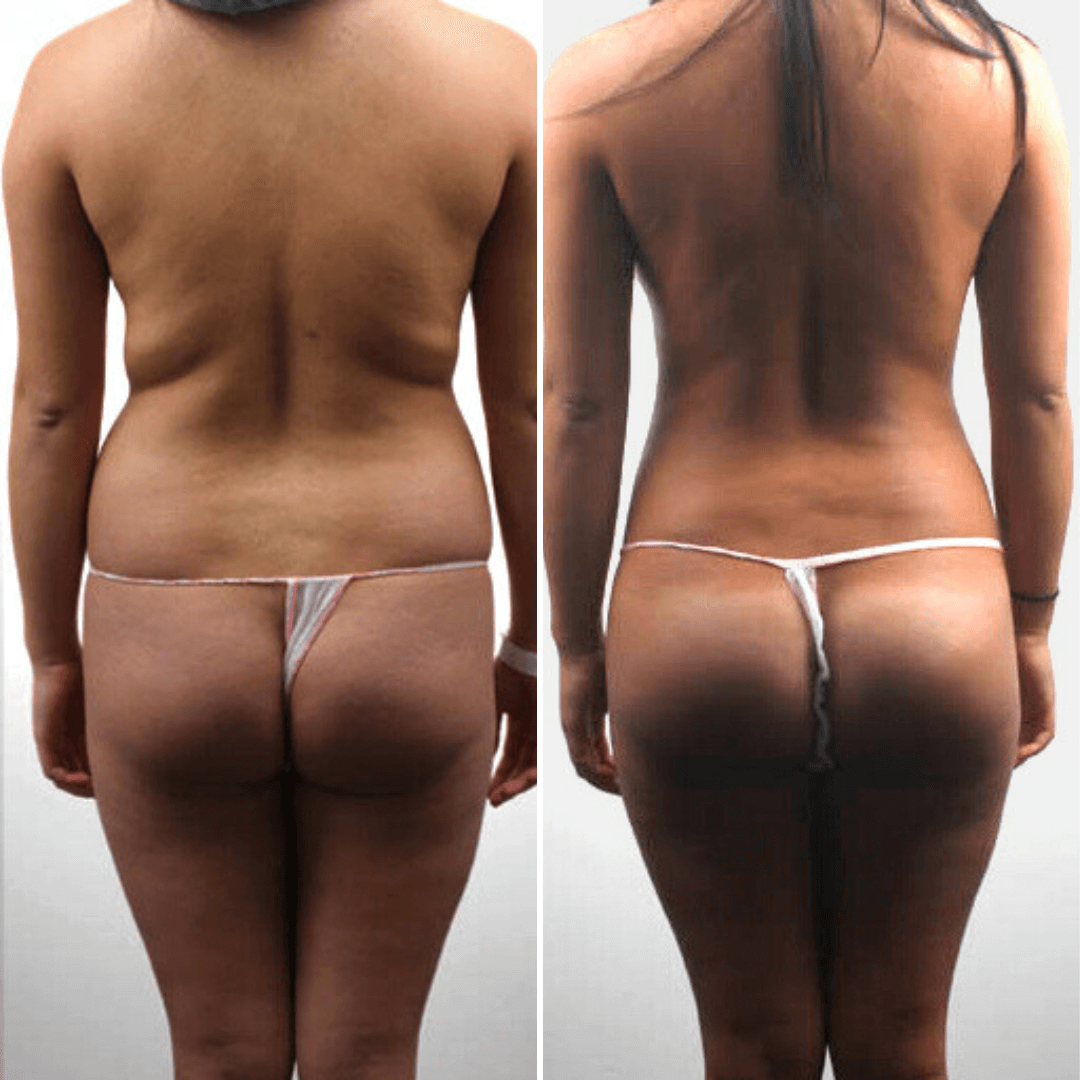
Liposuction can be performed on areas of subcutaneous fat. This is fat that is between the skin and muscle layers. Visceral fat, the fat that is inside the abdominal cavity amongst the organs, cannot be liposuctioned.
Some examples of treatment areas for liposuction include the following:
-
- Abdomen and pubic area
- Flanks and waist
- Hips and buttocks
- Inner and outer thighs and knees
- Calves and ankles
- Neck and chin
- Back
- Arms
This result displayed above is only relevant for this patient and does not necessarily reflect the results other patients may experience. The outcome of each procedure cannot be guaranteed, and individual results may vary for many reasons including genetics, diet and exercise. Every medical procedure carries its own set of risks, side effects and potential complications. Prior to undergoing any treatment, it is necessary to have a consultation to assess your suitability for the procedure. Patient consent has been obtained to display these images.
What are the differences between male and female liposuction?
Liposuction for women
Women tend to have more variation in their fat distribution. Fat accumulation may occur in the abdomen, hips, waist, thighs, calves, neck, arms or back, although women tend to fall into three main body types;
Gynoid – Fat accumulation occurs mainly in the buttocks and thighs. The upper body, including the abdomen, breasts and arms, tend to remain thinner.
Android – Fat accumulation occurs mainly in the upper body. The abdomen, hips, waist, back, arms, and breasts tend to be more significant. The neck tends to accumulate fat. Legs often remain very slim in comparison to the upper body.
Hourglass -Fat distribution is towards the buttocks and breasts, and the waist remains thin.
Note that variations in body shape are normal. Liposuction should not be used to attain an acceptable or ‘ideal’ body shape.
Liposuction for men
Men tend to be more similar in fat distribution and body shape than women and tend to accumulate fat in the neck (double chin), chest, abdomen, and flanks, which refers to the waist side area between the ribs and the hips. Treatment of the male chest often requires the surgical removal of glandular tissue (gynaecomastia) in conjunction with liposuction.
Typically, the male abdomen has more of visceral fat, or fat stored within the abdominal cavity, in proportion to subcutaneous fat, than women. This makes liposuction of the abdominal subcutaneous fat in men less likely to produce a difference in the girth of the abdomen in comparison to women.
How much fat can liposuction remove?
The amount of fat that can be removed during liposuction depends on your weight and BMI (Body Mass Index). Generally, no more than 5 litres of fat should be removed per session. Removing more significant volumes of fat can increase your risk of experiencing complications, and generally, it is recommended that liposuction should be broken into multiple smaller sessions if required.
Many patients and doctors want to remove as much fat as possible through liposuction. However, meticulous and even fat removal within the limitations of the skin’s elasticity, allowing the skin to retract and leaving a layer of fat behind, reduces the risk of dimply skin after liposuction.
Who can have liposuction?
The ideal candidate for liposuction is a non-smoking adult man or woman who leads a healthy lifestyle, has no pre-existing medical conditions, and is in good physical condition. It is best if the patient is within their ideal weight range beforehand and hasn’t experienced significant weight fluctuations in recent years.
Good skin elasticity is essential for anyone considering liposuction. The ability of the skin to retract after the removal of fat (and volume) may largely determine the quality of the result. Ultimately, skin elasticity is critical in determining one’s suitability for the procedure. Weight fluctuations, that is, significant weight gain and weight loss, increasing age, and genetic factors may negatively affect skin elasticity.
A consultation with a practitioner is required to determine your overall suitability for liposuction.
Who cannot have liposuction?
Some candidates may not be suitable for a liposuction procedure. This includes people who;
- Are pregnant or breastfeeding
- Have a blood clotting or bleeding disorder
- Have medical conditions that could increase the risk of complications during the procedure, such as cardiac or respiratory problems
- Those with a BMI greater than 30 (although a BMI of 30 alone may not preclude you from liposuction in general, at Victorian Cosmetic Institute, we enforce this as a rule.)
- Have lost significant weight, resulting in loose skin in the areas you wish to be treated
Those with significant skin laxity due to ageing, weight loss or pregnancy may not be suitable for liposuction, as it could result in increased skin laxity or skin irregularities. Skin tightening or skin reduction surgery (e.g. abdominoplasty or tummy tuck) may be required before liposuction if skin laxity is significant.
What age should I have liposuction?
Fat distribution patterns are genetic and tend to increase with age and weight gain. Skin elasticity is better the younger you are. Given these facts, it may be argued that liposuction should be done at an earlier age while the skin elasticity and general health are optimal.
Should I have liposuction before or after I lose weight?
Often patients ask if they should have liposuction before or after weight loss. For those who are significantly overweight, it may be prudent to lose weight first. This will reduce the risks involved with the surgery and allow a greater percentage of fat to be removed. Achieving a healthy and sustainable weight is recommended before any liposuction. Liposuction will only be performed on patients with a BMI (body mass index) under 30 at Victorian Cosmetic Institute.
Should I have liposuction before or after pregnancy?
The other question women often ask is, ‘should I have liposuction before or after pregnancy?’. As with most cosmetic or surgical procedures, liposuction is not recommended during pregnancy or breastfeeding periods. However, it is reasonable to suggest that women contemplating liposuction should have the procedure before pregnancy rather than delaying it until after. The integrity and elasticity of the skin are better before pregnancy in most cases, which allows the skin to retract following surgery. Also, by removing the fat stores before pregnancy, these fat stores are less likely to expand during pregnancy and cause undue stress and stretch on the skin.
How to prepare for liposuction
Before getting liposuction, you should ensure that you are as healthy and fit as possible. This will aid the effectiveness of the procedure as well as the recovery. Ceasing smoking before liposuction may help reduce the risk of the anaesthetic and surgery and improve the speed of recovery.
The consultation process
Your medical history, medications, past surgical history, weight and body shape will be considered, and your suitability for liposuction will be assessed.
The doctor will assess your body shape and fat distribution. Skin-fold thicknesses and body circumferences will be taken. An overall assessment of the body fat distribution will be performed to determine the areas most suited to liposuction.
Skin elasticity is assessed. The degree of fat removal needs to be balanced with the skin’s ability to retract afterwards.
Tests
Before the procedure, depending on your health and the areas to be treated, you may also be required to have some tests. These may vary from patient to patient, depending on your circumstances.
Blood tests
Your haemoglobin levels, platelet counts, kidney function, liver function, thyroid function, cholesterol, blood sugar level, blood clotting, and other tests may be requested before liposuction. A pregnancy test may be required to be performed if you are a female of childbearing age.
ECG or electrocardiograph
For those with a history of cardiac problems or for those over 60.
Imaging studies
An ultrasound may be performed in those undergoing liposuction for gynaecomastia to determine the amount of fat and glandular tissue present. It may also help determine the presence of hernias or divarication of the rectus (abdominal) muscle, which may need to be repaired before liposuction.
Compression garments
You will be measured and fitted for a compression garment that needs to be worn after the procedure.
Medications
You will also be given a prescription for analgesics to be taken post-operatively.
Liposuction local anaesthesia: Local, twilight or general
Liposuction can be performed under local anaesthetic alone (fully awake), ‘twilight’ sedation, or with a general anaesthetic. The type of anaesthetic used will depend on the patient’s and doctor’s choice, and the extent of the liposuction required;
Local anaesthetic only (awake)
Liposuction under local anaesthetic only was first devised and performed by Dr Jeffrey Klein over 20 years ago. There may be discomfort or pain experienced as the local anaesthetic is infiltrated into the treatment area. It is most suited to more minor liposuction procedures.
‘Twilight’ sedation
Liposuction can be performed with intravenous medication and local anaesthetic. The patient is sedated but often able to talk or respond to commands. The memory of the procedure may be hazy or intact depending on the drugs given and the individual’s response to these drugs. The patient may be prone to moving during the procedure. There is a limitation to the degree of sedation that can be given as no airway is used. Over-sedation may lead to obstruction of the airway. The balance between over and under-sedation is difficult.
General anaesthetic
In most cases, liposuction is performed under general anaesthetic. Local anaesthetic is still used in smaller amounts and can reduce post-operative pain. A general anaesthetic involves an airway, a deeper form of anaesthesia than twilight sedation. Because it is a more profound anaesthetic, patients do not tend to move, allowing the doctor to perform the procedure without interference from patient movement.
The liposuction procedure
Upon your arrival at the day surgery, you will have a final pre-operative consultation with your doctor before the procedure. Your doctor will mark and photograph the areas to be treated.
As liposuction is a sterile procedure, your skin is cleaned with an antiseptic solution. Incisions are made in the skin to allow access to the fat to be removed. In most cases, they are made in inconspicuous areas such as a skin crease, so they cannot be easliyseen once healed. The number of incisions made will usually depend on the area treated, and the access required. Most areas need 2 access points to ensure even fat removal.
From these incisions, the local anaesthetic solution is infiltrated into the fat of the treatment area. The local anaesthetic solution is a mix of;
- Saline
- Local anaesthetic
- Sodium bicarbonate (optional) – this reduces the discomfort from the administration of the local anaesthetic. Not required if under a general anaesthetic.
- Adrenaline – this helps to constrict the surrounding blood vessels. By doing so, this reduces bleeding, bruising, and keeps the local anaesthetic from being absorbed into the systemic circulation.
Once the local anaesthetic solution has been infiltrated into the fat, the area becomes swollen, and the fat layer becomes expanded, allowing for passage of the cannula and fat removal. The skin overlying the area becomes blanched from the adrenaline in the local anaesthetic solution.
A cannula (a thin metal tube with a blunt tip and small holes at the end) is used to pass through the area to systematically remove some of the fat. Light suction is provided by a machine or syringe (with its plunger pulled back) at the end of the cannula. The removal of fat relies mostly on the rasping action of the cannula’s holes rather than the suction.
Your doctor should constantly assess the areas treated for fat thickness and evenness by visual examination and pinching the area. The end-point for liposuction is not when all the fat is removed but when enough fat is removed to provide a smooth contour and shape.
The entry points are then sutured or left open to drain the infiltrated local anaesthetic, depending on their position and the doctor’s preference.
A compression garment is worn immediately after the procedure. It is recommended for 6 weeks and helps reduce swelling and bruising. Importantly, it helps the skin retract after the fat is removed.
Power-assisted liposuction and Renuvion
Power-assisted liposuction and Renuvion (also known as J-plasma) are devices used at Victorian Cosmetic Institute by Dr Gavin Chan.
Power-assisted liposuction
This technique involves using an oscillating cannula powered by an electric motor. The tip of the cannula moves back and forward by a few millimetres in addition to the larger back-and-forth movements created by the doctor. The advantages of this technique include; less operator fatigue, easier and smoother fat removal, and less trauma to the tissues treated as the oscillating tip passes through fibrous tissues. The downside of power-assisted cannulas is that they can reduce the feel or feedback from the cannula. This makes it more difficult to discern which plane or depth the cannula is in. The power assistance can be switched off for delicate areas or when added feedback is needed.
Renuvion (J-plasma)
Renuvion utilises plasma energy, which is intended to help tighten the skin after liposuction. It uses radiofrequency-activated helium gas to create plasma and contract the tissue underlying the skin. This energy is delivered to the fibroseptal network underneath the skin to maximise the soft tissue’s contraction and improve the area’s contour and laxity over time. The application of heat to the underlying skin tissue promotes neocollagenesis. Neocollagenesis is the reformation of additional collagen following repair to the controlled injury to the soft tissue layer.
By improving skin contraction, it is possible to reduce the likelihood of skin laxity post-liposuction.
This result is only relevant for this patient and does not necessarily reflect the results other patients may experience. The outcome of each procedure cannot be guaranteed, and individual results may vary for many reasons including genetics, diet and exercise. Every medical procedure carries its own set of risks, side effects and potential complications. Prior to undergoing any treatment, it is necessary to have a consultation to assess your suitability for the procedure. Patient consent has been obtained to display these images.
Liposuction aftercare
Immediately following the procedure, you will enter the recovery room where you will spend a couple of hours. Once ready to be discharged from the day surgery, you will be able to go home, but you will need to arrange for transport home because you will not be able to drive. You will require a friend or family member to take care of you when you arrive home. This adult friend or family member must stay with you overnight.
After liposuction, there may be some drainage from the wounds. Usually, this fluid is absorbed by pads that are placed inside the compression garment. They may need to be changed, depending on the degree of drainage.
You will be prescribed painkillers or analgesia post-liposuction. Usually, the local anaesthetic given during the procedure takes a few hours to wear off, so you may not require pain relief for some time after the procedure. The pain from liposuction is often likened to muscle soreness after a heavy workout, and in most cases still permits you to do light activities.
Your regular exercise routine can be gradually resumed, usually after a week, once the discomfort has settled down. In most cases, you can return to work after a few days, but this depends on the number of areas treated, your recovery speed, and your line of work. Most people with office jobs can return to work after a few days, but this can vary.
The compression garment needs to be worn for several weeks post-procedure. Showering and garment removal should be minimised, especially during the first week.
Your post-operative check-ups will occur regularly during the first week following your procedure. Sutures are removed on or around day 7.
How long does liposuction last?
Typically, once the fat cells have been removed through liposuction, they typically don’t grow back, but you will still have other remaining fat cells.
The outcome of each procedure cannot be guaranteed, and individual results may vary for many reasons including genetics, diet and exercise. Every medical procedure carries its own set of risks, side effects and potential complications. Prior to undergoing any treatment, it is necessary to have a consultation to assess your suitability for the procedure.
Does liposuction leave scars?
Yes. Incisions are made in the skin to allow entry of the liposuction cannula, which heals by forming a scar. The degree of scarring formed will depend on:
- Skin type (darker skins tend to have darker scars and a greater tendency towards keloid scars)
- Location of the scar – scars in areas of high skin tension may cause greater scars. Those placed in areas of lower skin tension, for example, in a skin fold or crease, may have less scarring.
- Use of ports – without skin entry ports, the liposuction cannula rubs on the skin as it passes in and out of the body. This can increase the skin healing time and scarring.
Although scarring is inevitable with liposuction, it is crucial to consider the impact of these scars on the final post-operative appearance and minimise scarring when possible. This can be done by:
- Placing incisions in inconspicuous areas when possible – for example, on the abdomen, scars can be placed inside the umbilicus (belly button), in the breast creases/fold, and in the groin crease rather than in the middle or front of the abdomen.
- Creating the fewest number of incisions required to perform the liposuction adequately
- Using ports to protect the skin from rubbing from the cannula.
Possible risks and side effects of liposuction
As with any surgical or cosmetic procedure, there are risks as well as benefits to the procedure. Overall, when done correctly, liposuction is an effective procedure to remove unwanted areas of fat.
Any surgical or invasive procedure carries risks. You should discuss these with your doctor.
Complications from liposuction can be broadly categorised into cosmetic and medical or surgical complications.
Cosmetic complications
Cosmetic complications are usually from over or under-liposuctioning a particular area and result in outcomes that may not be satisfactory to the doctor or patient.
Proper patient selection is an integral part of reducing cosmetic complications. For example, a patient with poor skin elasticity may not achieve the desired results due to poor skin retraction post-procedure. Also, it is vital for the doctor to properly manage the patient’s expectations prior to the liposuction and give them realistic expectations of what can and cannot be achieved.
Skin irregularities
Sometimes the skin may appear uneven, bumpy or withered after liposuction. This is usually caused by over-liposuctioning, uneven liposuction, or too superficially liposuctioning an area. The best way to avoid this is to choose an experienced doctor, maintain a stable weight before and after surgery and follow your doctor’s instructions during recovery.
Skin laxity
Over-liposuctioning of an area can reduce fat to the point where the skin cannot retract adequately or evenly, and may result in loose, irregular or wrinkled skin. The looser the skin to begin with, the more likely it is that this will happen. Your doctor may recommend a skin tightening treatment with liposuction if you likely experience this complication
Missed areas
With an experienced doctor, having missed areas is an uncommon complication. Having a touch up procedure can help correct this complication. A touch up procedure may involve having a small amount of liposuction to an area that is irregular after the initial liposuction, or transferring fat from another part of the body to correct over-liposuctioning.
It is important to note that the final shape from liposuction is not usually achieved for 6 months, and that tissue remodelling occurs for about 1 year. Therefore, touch ups or follow up treatments are usually best left for at least 6 months after the initial procedure.
Medical complications
Medical or surgical complications make up a much smaller percentage of the complications that occur from liposuction.
Liposuction performed under general anaesthetic or sedation carries the usual risks associated with the use of anaesthetic agents.
Excessive blood loss
Excessive blood loss with today’s modern liposuction techniques is extremely uncommon, especially if the candidate has been appropriately assessed beforehand. If the patient has no severe health conditions and is not on any blood-thinning medications, they are unlikely to suffer this complication. Blood loss can occur if the patient engages in high-intensity activities immediately after the procedure, which is why this is not recommended.
Infection
Infection after liposuction is unlikely due to the sterile procedures in place during the treatment. A sterile field is always maintained during the procedure, all equipment used is sterile, and the anaesthetic solution given to numb the fat is sterile. However, you should contact your doctor immediately if you notice signs of infection after liposuction, such as fever, excessive pain, or redness in the skin.
Lignocaine toxicity
Lignocaine is the local anaesthetic agent used in most liposuctions, which can be used up to a certain level based on the patient’s weight. Some drugs taken by the patient, including conventional and herbal medications, may interfere with the metabolism of lignocaine. Therefore it is important to disclose any medications you are taking to your doctor. As long as the doctor knows this, they can take the necessary precautions.
Haematoma
A hematoma is a collection of blood under the skin. Usually, modern compression garments and the foam applied post-surgically prevent these, but they may require drainage. This is an uncommon complication, and your doctor may advise you to observe it for some time before action needs to be taken.
Seroma
A seroma is a collection of fluid under the skin that requires drainage, usually daily. Again, compression garments help to reduce seroma formation significantly. They are more common with ultrasonic liposuction than other liposuction techniques.
Deep vein thrombosis
Deep vein thrombosis, also known as pulmonary emboli, can result from surgery because the relative reduction in movement after surgery can promote blood clots. These clots can then embolise to the lung (pulmonary emboli). You need to let your treating doctor know if you have a history of deep vein thrombosis so that appropriate measures can be taken. Liposuction done under local anaesthetic has a lower chance of causing deep vein thrombosis than liposuction done under general anaesthetic. This is because you can still use your muscles during liposuction under local anaesthetic, which helps promote circulation and prevent blood stasis. Maintaining movement after surgery, such as being as mobile as is comfortable following surgery, will reduce the risk of developing pulmonary emboli.
Overall, although complications cannot be avoided entirely, with proper patient counselling, patient selection, and surgical technique, the risk of complications can be significantly reduced.
Where should liposuction be performed?
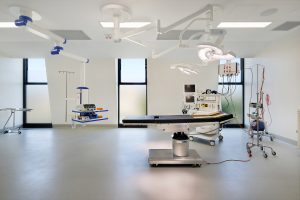 In Australia, liposuction of greater than 200mLs must be performed in an accredited day surgery facility or hospital.
In Australia, liposuction of greater than 200mLs must be performed in an accredited day surgery facility or hospital.
Accreditation helps to ensure specific criteria have been satisfied and that the facility will be of a high standard.
At the Victorian Cosmetic Institute, we perform liposuction at VSC Day Surgery, located in Lower Templestowe (pictured below).
How to choose a doctor for liposuction?
Doctors from various training backgrounds or specialties can legally perform liposuction in Australia. Important considerations when choosing a doctor to perform liposuction may include the following.
Experience
When researching for your liposuction procedure, ensure you go to an experienced and qualified practitioner. Look for the following information:
- How many cases of liposuction have they done.
- How often do they perform the procedure.
- Previous patients that they have had and whether they had similar concerns.
You should also ensure that the operation will be performed in a registered hospital or day surgery facility.
Understanding your individual body shape
It’s essential that the doctor understands your specific needs and concerns. Do they understand what areas need to be treated with liposuction to address your concerns? You should ensure the doctor can perform liposuction on the area or areas of the body you require.
Surgical skills and ability to perform surgery
It is difficult to determine one’s surgical skills without a proper assessment, but you should look at their previous results and before and after photos. Reviewing photographic case studies of liposuction performed by the doctor will assist you in making your decision.
Judgement
In your initial consultation, you should ask questions to ensure you understand exactly what will happen during the procedure and what results you should expect. Is what they are proposing to you a carefully considered and structured plan? Can they explain the rationale behind the surgical treatment plan they are proposing? Have they openly discussed the risks of the procedure?
It is important that you feel comfortable with the doctor you have chosen.
Reputation
A couple of ways to assess a doctor’s reputation include:
- Finding out how many patients they have treated using liposuction
- Asking for referrals from other doctors
- Checking whether they have published any articles or sources of information about the topic
- Researching the doctor online to find independent reviews
Communication skills
This is about how satisfied you are with their ability to explain information. Are they able to communicate with you effectively? Are you comfortable expressing your concerns to them? Do they effectively communicate their plan to you? Are they contactable after your procedure in case of any urgent questions or complications?
How much does liposuction cost?
The price of liposuction will depend on the areas treated, the number of areas treated and the type of anaesthetic used.
It is important to realise that certain areas may need to be treated in conjunction with others. For example, it may be prudent to treat the hips if the outer thighs are being treated. Otherwise, they will tend to look out of proportion. Therefore, we advise that a consultation be undertaken to ascertain what areas might need to be treated to improve your treatment outcome.
All post-liposuction review appointments are included in the price of the liposuction.
Theatre fees will depend on the length of the operation.
An anaesthetist’s fee will apply. This will depend on the anaesthetist and will depend on the time taken.
Because liposuction is a cosmetic procedure in most cases, it does not attract rebates from private health insurance.
The cost of the liposuction surgical fees will depend on the extent and time required to perform your liposuction and can only be assessed at the time of consultation.
FAQ
Should you lose weight before liposuction?
There is no specific target weight for those considering liposuction, but it is important to be within the range of your goal weight. Many recommend being within 30% of your ideal weight before having the procedure, depending on your body composition. You must also have a BMI (body mass index) below 30.
However, you will also need to maintain a stable weight before and after the procedure. So you should be fit and healthy at a weight you can maintain.
How long after liposuction can I exercise?
You should wait at least four weeks before exercising again. Even after this period of recovery, you will need to start slowly and look out for any concerning symptoms, such as pain or bleeding around the treatment area. If you begin feeling light-headed or dizzy, that’s also a sign that your activity is too intense.
How long does it take liposuction to heal?
Your recovery time will depend on the areas you have treated and the size of these areas. Those who have a small area treated will usually be able to return to normal activities relatively quickly, whereas a more extensive treatment area may require more downtime.
Your doctor will be able to give you a more specific timeline before the procedure.
Do I need a GP referral for liposuction?
All patients who are seeking cosmetic surgery, including liposuction, are required to have a referral. The referral should be from your regular General Practitioner or other specialist medical practitioner.
For the referral to be valid, the medical practitioner providing you with your referral must work independently of the practitioner with whom you wish to perform your procedure. Additionally, the medical practitioner writing your referral for cosmetic surgery must not perform any cosmetic surgery or non-surgical cosmetic procedures themselves.
We request you bring your referral with you and hand it to reception at your consultation appointment.
Why choose the Victorian Cosmetic Institute for liposuction in Melbourne?
Dr Gavin Chan MBBS, General Registration (MED0001175745) at the Victorian Cosmetic Institute is highly experienced in liposuction and has been developing and refining liposuction techniques for many years. He has performed liposuction since 2009. All of Dr Chan’s liposuction is performed in an accredited day surgery facility registered with the Department of Health and Human Services and utilises dedicated liposuction equipment and machines such as the Microaire power-assisted liposuction machine and Renuvion.
Our doctors and nurses provide a high level of patient care, and the hospital facilities where Dr Chan operates are maintained to the high standards required by the Department of Health and Human Services.
As each person will have different requirements, we tailor each treatment to suit the needs of each patient specifically, and we are very thorough in our assessments before the procedure.
A liposuction procedure can help you remove fat deposits from your body. All operations carry risk, and a consultation to determine suitability is required. Book a consultation with Dr Chan by phoning our Customer Care team on 1300 863 824.
